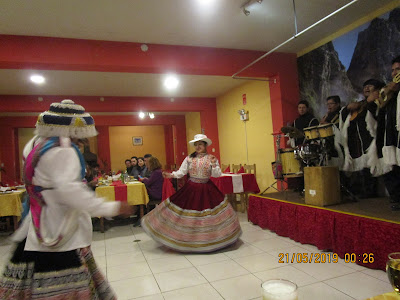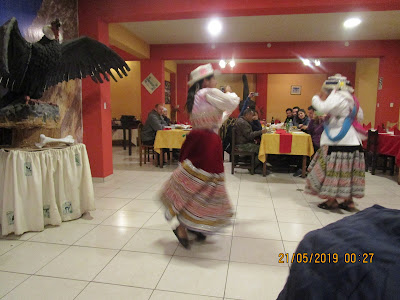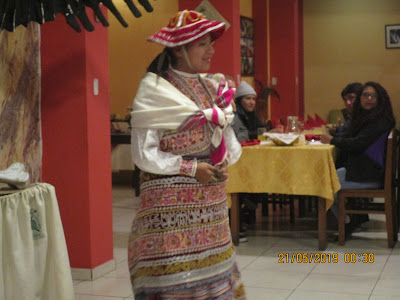This was the first vicuna we saw. The vicuna is one of 2 wild South American camelids the other being the guanaco. I don't think we saw a guanaco. One of the world's most expensive fabrics comes from the wool of the vicuna. Vicuna are yellow and brown in colour.
We saw quite a lot of vicuna, particularly near water.
We passed alongside the Chachani volcano. The Misti volcano is still active.
We stopped at a roadside cafe and craft shop for coca tea and a pee. I was totally breathless just walking from the loo to the cafe - basically across the road. My head was splitting! I planted myself on a chair and just took in the surroundings. Jim had to get Inca tea for me. He also got some coca sweets.
Mate de coca (coca tea) is an infusion of coca leaves. It is very popular in Peru as a digestive tea and is widely used to treat altitude sickness - it didn't seem to make any difference to me. There is some international pressure on Peru to make cocas leaves illegal because in many countries (and in Peru also) they are used to make cocaine. However, it has to be understood that it takes 370 grams of coca leaf to make it gram of pure cocaine. It has to be remembered too that in Peru coca leaves are not a recreational drug but are used for medicinal purposes. Inca tea, as in the infusion we got here at Yura, seems to be similar to coca tea but it includes a lot more leaves and herbs.
These rocks are a result of volcanic action and shaped by wind erosion.
We stopped farther on to see llamas and alpaca. Then we continued on our way to the Mirador de Patapampa, the highest point at 4, 910 metres on the way to Chivay. The pass between Arequipa and Chivay is one of the highest elevated passes in the world. It is no wonder I was feeling so rotten!
Llamas have long banana shaped ears and alpacas have shorter straight ears. They can be black, white, brown or reddish. Llamas are bred as pack animals and for meat. Alpacas are bred for their wool and for meat. The alpaca produces a much finer fibre than the llama. Tassels are placed in therir ears to distinguish one animal from another or to distinguish between who owns which animal.
Area of peat bogs
The rock formations were fascinating.
Ampato volcano where Mummy Juanita was found. From here we could see the smoking volcano but for some reason Jim has no photo of it here.
Breathlessly holding on! I had a pounding headache and was very dizzy. Henry gave us all some rosewater to smell like smelling salts.
The whole area was filled with rock sculptures, called apachetas in Peru, which would suggest that lots of tourists spend time here. Seemingly the real value of apachetas was spiritual. The stones were picked up and carried along the trail and then placed on an apacheta as a sacrifice to the gods. They were seen as having supernatural powers and connecting with them through prayer was said to bring good luck and protection. The whole area is a bit reminiscent of a martian landscape.
The scenery coming down into Chivay was quite spectacular.
When we got to Chivay we went for a buffet lunch. The food was excellent. I had a lovely selection of vegetarian starters. Then I had just a little chicken, beef, vegetables and puree of potatoes. For dessert there was fruit, banana fritters, lemon cheesecake and fruit mousse.
When we got to Casa de Lucila we were allocated our rooms. I went to bed to rest and Jim went out for a walk. Charlotte was also resting and Sarah went to the hot springs. We were all to meet at 6.45 to go out to dinner and watch some traditional dancing.
Jim got lots of photos of the Plaza de Armas in Chivay on his walk. When he came back I went out to have a look round too. It is a very pretty place with interesting traditional statues.
Peruvians are into crosses in a big way. This was on a hillside over Chivay.
Musical fountain!
The church was being renovated but was really nice inside.
I think a lot of these statues are to do with traditional dances.
A bit scary!
Charlotte and I took a tuk tuk/moto taxi to the dinner venue (Kuntur Pena) which was very helpful as I was feeling so sick. I couldn't eat and ordered chicken noodle soup which I dipped into once or twice. It was tasteless or else I was just too sick.
The music and dancing was very good. We were in a great position to see the dancing which replicated traditional dances from the Colca Valley.
Some of the musicians were very talented playing many instruments.
This man and woman were dancing a form of the traditional dance from the Colca Canyon area called Wititi. In the Colca Valley there are two traditional cultural groups - the Aymara speaking Collagua and the Quechua speaking Cabana. The Wititi is the most important expression of these two groups.Oral local tradition says that this dance originated as a remembrance of military conquest in which males, called "Wititis" dressed in women's clothes to confuse their enemies. Other sources say that wearing female attire was a trick for males to seduce young girls without rousing suspicion.. To perform the dance wititis use 2 overlapping skirts distinctive of the cultural groups of the Colca Valley. On the torso they wear a military jacket and 2 traditional blankets. They carry a woven sling (waraca) which they wave during the dance imitating the throw of a stone. On their head they wear a very decorative hat (somewhat similar to a lampshade) with fringes falling over their face. Women dance wearing their traditional costume. The designs on the skirts (beautiful hand-embroidered works of art) are the flora and faunas of the Colca Valley. The shirt and waistcoat are also embroidered with motifs from nature. Variations in design depend on their district of origin. The dance takes place in the religious and civic celebrations of the Colca Valley usually during the rainy season from December to March which marks the beginning of the agricultural calendar. Today the dance is performed with a clear meaning of love expressing the joy of courtship as well as the complementary nature of male and female. Young people in this area (and possibly throughout Peru) learn to dance as soon as they can walk and the dance is passed on from generation to generation. It has become a symbol of identity and is considered to be the most important expression of the living culture of the Colca Valley.
After their performance the dancers chose people from the audience to try out the dance. Our Sarah was chosen and willingly participated.
Masks are frequently worn in Peruvian dance. The knitted masks are called "Waq'ollo" They represent mythical figures.
This dance is called the "Malaria dance". In it a dancer faslls to the ground and his/her partner then, using a whip, whips him/her. It was hard to figure out why.
This was our driver who was cajoled into taking part.
This must have been a condor dance.
Dave, a member of our group, from Australia, took part here.










































































































































No comments:
Post a Comment